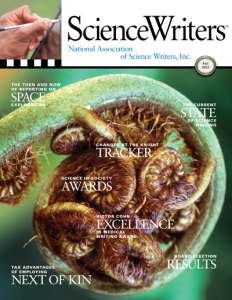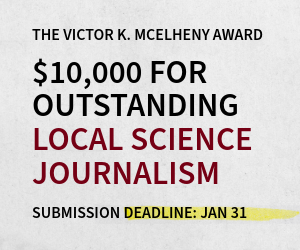The Food & Environment Reporting Network
A new media outlet for freelancers
By Maryn McKenna
On July 11, 2012, an investigation I had worked on for approximately six months appeared simultaneously on TheAtlantic.com, Good Morning America, and ABC News’ World News Tonight.
I am a freelancer.
If you know anything about the freelance marketplace, you’ll spot at once that those two sentences don’t go together. Freelancers, regardless of the quality of their work, do not routinely find the money to support months of independent research, and people who are not staff reporters do not commonly end up on network news, let alone in a multi-platform project co-published with the website of a major magazine.That my project ended up in so many places at once is due in part to the innate newsworthiness of the story, which drew a connection between antibiotic use in agriculture, chicken, and rising drug resistance in urinary tract infections. But it is due much more to the creativity and tenacity of an almost two-year-old organization that was founded to support writers like me and many other NASW members: Experienced freelancers who have spotted a story that needs a deep dive, but do not have the funding to pursue it or editorial connections to get it showcased.
The group is the Food & Environment Reporting Network, Inc. (thefern.org), a nonpartisan nonprofit started in late 2010 by former staff reporters and longtime freelancers who knew from their own work lives — and from talking to friends and colleagues — that excellent stories were going unpublished.
“We started talking initially at a conference, over beers,” says Sam Fromartz, a former Reuters business editor, freelancer, and author of Organic, Inc. (Houghton Mifflin Harcourt, 2006), who is FERN’s editor- in-chief. “We knew there were really talented people out there who were trying to write about food, agriculture and environmental issues, but weren’t finding the support that would enable them to do the reporting.”
The group formed a board, recruited a separate editorial board (members include former Gourmet editor-in-chief Ruth Reichl and former WIRED editor-in-chief Katrina Heron) and sought funding. The first grants were small, Fromartz said — hand-to-mouth funding, at about $10,000 a time, but enough to pay lean bills while the group applied to big foundations. They were successful; their funding sources now include the 11th Hour Project (backed by the Schmidt Family Foundation), the McKnight Foundation, Clarence Heller Charitable Foundation, Columbia Foundation, and the David and Lucile Packard Foundation.
With the decay of the mainstream media, foundation-funded journalism has become common. The most notable examples are the investigative powerhouses ProPublica, backed by the Sandler Foundation; the Center for Investigative Journalism; and Center for Public Integrity. Smaller outfits range from regionally specific publications such as the Texas Tribune, VoiceofSanDiego.org, and California Watch, to health-news sites in Florida, Georgia, North Carolina, and others. But most of those sites have used their grants in part to hire permanent reporting staff. FERN, like the Investigative Fund at the Nation Institute, is one of a handful that commissions work from an array of freelancers, whose work it subsequently markets to traditional media outlets. Among its hits so far: High Country News, MSNBC (since renamed NBCNews. com), Washington Post, The Nation, American Prospect, in addition to The Atlantic, and ABC News. Placements with additional major media are in the pipeline.
Fromartz emphasizes that FERN is not a grant making organization, giving reporters funds to go out and explore a topic. Rather it is a media organization, commissioning stories, pitches them to partners, and getting pieces published or broadcasted.
“There was a real question in my mind whether we could achieve liftoff, but now I do feel this is sustainable,” Fromartz says. “We have shown we can deliver great stories and we can attract reputable media partners. That means we can demonstrate to writers that they will get to work with quality editors, and their stories will have impact. And as a result, we’re getting really great pitches.”
Pay arrangements vary by project: If a story is going to a single outlet, the reporter may be paid directly by the publication; for multi-platform projects such as mine, the reporter may be paid by FERN. (I was.)
“The pay depends on the story and on what the media partner is bringing to the table,” Fromartz says, “But we aim for competitive rates.”
For complex projects, FERN also offers “research commissions” that usually run around $1,000. At the end of that process, the writer should have a polished pitch that is strong enough to stand up to scrutiny by FERN’s own editors followed by editors at its eventual landing place.
In exchange for that decent pay rate, FERN is looking for stories that are original and will have impact: Its previous hits this year have included investigations of how the government crop insurance program props up insurance companies, how dairy farming imperils groundwater, and how a drug that is routinely fed to U.S. livestock has become so controversial that its use prevents U.S. meat from being sold in many countries. “We want food, agriculture, and environmental health,” Fromartz says, “But those encompass such a broad range that, we’re open to anything as long as it relates to our core areas. Our entire mission is to do stories that other media are ignoring, but it still has to resonate with us and with the media we are marketing to.”
To pitch FERN successfully, Fromartz urges reading the website thoroughly, and then sending a short pitch — 200 words, max — through the submission engine on the site’s “Contact Us” page (thefern.org/contact). For now, projects must be U.S.-based; the group’s funding doesn’t yet extend to international travel. And while the stories FERN has placed so far have foregrounded print (with one multi-media slideshow), he is open to other media too. “We have radio partners who are looking for pitches,” Fromartz says, and FERN is also considering data analysis and graphic story presentations.
Maryn McKenna is a columnist and contributing editor for Scientific American, a blogger for Wired, a magazine journalist, and the author of Superbug: The Fatal Menace of MR SA and Beating Back the Devil. She is working on a second project for FERN.




